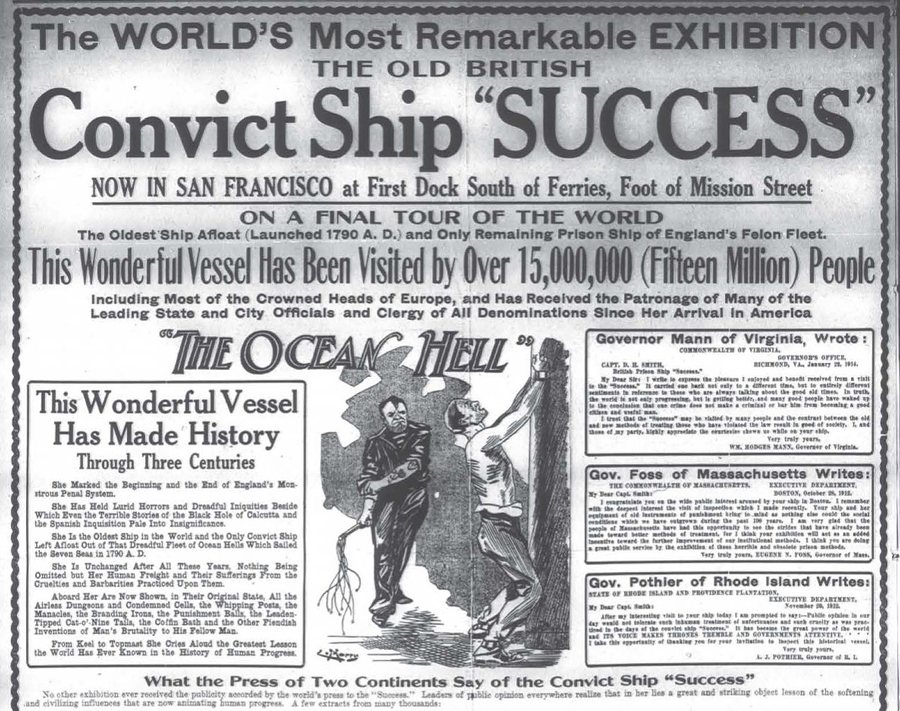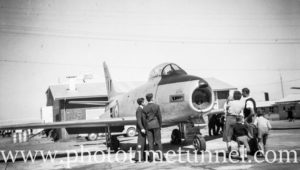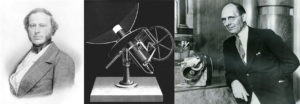Falsely touted as a former convict transport, the Success was a giant marketing fraud. But as a fake it was a commercial success in Britain and the USA, earning good money for its owners. Fakery aside, the career of the Success was certainly remarkable.
Recently I saw an article posted on-line that discussed the convict ships that brought the first unwilling European residents to what became Australia. A photograph that accompanied the article confused me, since it showed a row of prison-cell-style doors below decks on the ship which somehow didn’t match my understanding of how the convict ships were actually set up.
Serendipitously, a day or two later while browsing some second-hand goods, I spotted a book with the title: The History of the British Convict Ship “Success” and its most Notorious Prisoners. The book was clearly quite old, but had a cover price of 25 cents, which suggested an American origin. On the back of the book was printed the words: “Published on board the convict ship Success”. This seemed very peculiar to me, and when I leafed through the book I noticed one of the handful of photographs inside was similar to the image I had seen on-line a few days before.


Intrigued, I bought the book and straight away started to find out what I could about this vessel, apparently a relic of Australia’s convict past and also apparently on display in America. The book itself spins a yarn about the ship Success and weaves about the vessel a reasonable enough narrative of some of the worst horrors of the system of transportation of convicts to the Australian colonies. It dwells on tortures and punishments – many of them completely fictitious in the context of the British colonial penal system – as well as the lives and careers of various convicts, including some of the best-known bushrangers who had no connection to the ship at all. By the account of the book, the Success was at the centre of the system of colonial transportation.
Except it wasn’t. The book and the ship it describes is a blend of fact and fiction, ornamented and embroidered to suit a commercial purpose.
According to the story, the Success was built in 1787 and had a long career carrying convicts to Australia. The truth appears to be, however, that it was built in 1840 and was never a convict transport at all. Built in India, the ship began its career trading between Australia and Britain. There are reports of it carrying emigrants to Fremantle in 1843, when it was apparently blown ashore (and refloated). During this visit too, its skipper and three youths were apparently drowned while travelling to the anchored ship from shore on a boat.
The Success apparently delivered emigrants to Adelaide in January 1848 and then to Melbourne in 1849 and 1852. According to the book, The Convict Ships, by Charles Bateson, the crew of the Success deserted at Geelong in 1852 when they heard news of the Victorian gold rush and the ship’s owners could not raise a replacement crew.
The Victorian colonial government bought the stranded ship, along with four other similarly abandoned vessels – President, Deborah, Sacramento and Lysander – which it converted for use as “hulks” or floating prisons, moored in Hobsons Bay. Apparently the land-based gaols at the Port Phillip settlement were inadequate to meet demand during the wild gold fever period, so the five teak-built ships were bought to supplement the supply of prison accommodation. It was in this role that the Success most nearly approximated the “convict ship” it was later to be described as. Indeed, the Success is reputed to have been the hulk that housed the most dangerous of the criminals.

The convicts housed on the hulks were put to work ashore by day, many of them working at a stone quarry near Williamstown. It was here that some of the hulk convicts mutinied and murdered Victoria’s Inspector General of Penal Establishments, the notorious John Giles Price. Price had gained his notoriety while in charge of convicts at Van Diemens Land (Tasmania) and then on the prison colony at Norfolk Island. His reputation for cruelty became a byword. He was appointed to his senior position in Victoria in 1854 and quickly engendered great unease for his blatant cruelty. On March 26, 1857, he visited the prison hulk convicts at work at the Williamstown quarry, supposedly to hear complaints about ill-treatment. He and the handful of guards accompanying him were surrounded by about a hundred convicts who knocked him down and beat him to death. Seven of the convicts were subsequently hanged for the murder.
Success served as a convict hulk until 1858, according to Bateson, who added that it “later served as a women’s prison, a reformatory and dormitory for boys and an explosives hulk”. According to the account in the US-published book of the Success: “For many years the Success was moored in an out-of-the-way part of the Saltwater River and was employed as a store hulk for the powder and ammunition used by the Defence Department of the Colony of Victoria”.
According to Bateson, new owners took over the Success in the 1870s and decided to turn the ship into a floating museum, fitting it up as a supposed convict transport and charging admission to view the relics on display. This date may be incorrect, however. This article in The Australasian of April 26, 1890, suggests the ship’s museum career dated from that year.
Harry Power, the former bushranger noted for his connection to Ned Kelly, was apparently hired as a guide and tout, adding to the glamour of the exhibition. The ship was towed to Sydney, arriving on November 6, 1891. It was exhibited there for a time before being sold to new investors who announced plans to take the ship to England. This plan was thwarted when somebody scuttled the ship in Kerosene Bay where it lay underwater for six months before being refloated. An application to take the ship to England was refused on the grounds of seaworthiness, but the owners managed to sneak it out anyway.

To quote from the Success book: “For a time she was on exhibition in Sydney and even in that role her career was fraught with incident. Government was petitioned, influence was brought to bear and large sums were offered privately for her destruction. This failing, she was stealthily boarded one night, maliciously scuttled to disappear , it was hoped, forever. She lay below the picturesque waters of the harbor for nearly five years, but was then raised and being found comparatively uninjured, was again placed on exhibition”. A newspaper correspondent with an intense interest in the Success was a Mr A. T. Saunders, of North Adelaide, who commented that the sinking in Sydney was due to neglect, but this was “exploited and lied about”.
Before it went to England the Success made an appearance at Brisbane, as this 1893 article attests. The ship, moored at the foot of Edward Street, was open to visitors from 10am until 10pm daily, and the article noted that “the original dens and dungeons are now filled with wax figures of convicts, together with representations of the most notorious bushrangers”. It seems the ship also visited Hobart and Adelaide. It sailed from Semaphore (Adelaide) on March 30, 1895 and arrived in England after a voyage of 166 days.
The Success arrived in England and was displayed there as a museum of the convict era until 1912. According to this 1898 article, the ship’s owners were at that time making a healthy return on their investment. The owners were still doing well in 1906, as this article shows.
In 1912 the Success was bought by American interests who took it across the Atlantic to try their luck showing it to new audiences in various American ports. In June 1914 an advertisement appeared in some US newspapers inviting investors to buy shares in a corporation being formed to buy the ship from its apparent owner, Captain D.H. Smith. It isn’t known whether this plan proceeded.


In late 1915 advertisements appeared for a four-reel film depicting the ship and its gallery of titillating horrors. The film featured lecture footage by a “Professor J.C. Heerey”, described as “Australia’s leading authority on penal life and conditions”. I suspect the man in question was not a professor, but the mining engineer mentioned in this obituary. In 1917, during the shipping shortage caused by World War 1, it was reportedly going to be recommissioned for cargo use. Its next mishap came when it was caught in ice and sank on the Ohio River. It was raised once more and put back to work as a floating museum, apparently attracting big crowds at the Chicago World Fair in 1933.
The ship was apparently finally destroyed by fire at Lake Erie in 1946. According to an account in the Clinton News Herald of March 2, 1977, the old ship had been bought in 1944 by Port Clinton businessman Walter Kolbe who had it towed to his home town. “He is said to have stripped it of much of the upper decks, its prison cells and some records,” the report noted. “A mysterious fire on July 4, 1946, destroyed all but the lower hull. What remained sank in a few feet of water. It is still there.”






Fascinating story, Greg. Just not quite how we think of a convict ship, but in a way, it guess it was one, since was used as a prison hulk for a little while. Good work